Fast Charging of an Electric Bus Fleet and Its Impact on the Power Quality Based on On-Site Measurements
Abstract
:1. Introduction
2. Materials and Methods
- The Regulation of the Minister of Economy of 4 May 2007 on the detailed conditions for the operation of the power system (hereafter referred as the Regulation)—the fundamental document in Poland′s procedure of analyzing power quality for low, medium, and high voltage public power networks, with the last update in 2020;
- PN-EN 50160:2010—a subordinate document to the Regulation and in line with its requirements. This document introduces European standard EN 50160 in Poland. In 2015 and 2019 the PN-EN 50160 standard was updated and the requirements were tightened for Norway; however, as the Regulation in Poland has not been updated and it is the paramount of importance, the results will be analyzed in accordance with the 2010 version of PN-EN 50160;
- IEEE 519—contains recommendation for current distortion limits. It is not normative in Europe. The IEC 61851-21-2 standard [30] declares the use of national standards for current harmonic analysis for chargers with currents higher than 75 A (which is the case for fast and super-fast electric bus chargers); however, such a standard does not exist in Poland.
- Frequency variation,
- Voltage variation,
- Voltage asymmetry,
- Total harmonic distortion of voltage,
- Short-term and long-term flicker severity,
- Voltage and current harmonics.
3. Results and Discussion
3.1. Power Frequency
3.2. Phase Voltage
3.3. Voltage Asymmetry
3.4. Total Harmonic Distortion of Voltage
3.5. Voltage Harmonics
3.6. Short-Term and Long-Term Flicker Perceptibility
3.7. Current Harmonic Emission
4. Conclusions
Author Contributions
Funding
Acknowledgments
Conflicts of Interest
References
- Mathes, M.; Schmidt, M.; Käsgen, J.; Fievet, B.; Tichelen, P.V.; Berecibar, M.; Al-Saadi, M. Heavy-Duty Battery Electric Buses’ Integration in Cities Based on Superfast Charging Technologies: Impact on the Urban Life. Sustainability 2022, 14, 4777. [Google Scholar] [CrossRef]
- Lie, K.W.; Synnevåg, T.A.; Lamb, J.J.; Lien, K.M. The Carbon Footprint of Electrified City Buses: A Case Study in Trondheim, Norway. Energies 2021, 14, 770. [Google Scholar] [CrossRef]
- Mao, F.; Li, Z.; Zhang, K. A Comparison of Carbon Dioxide Emissions between Battery Electric Buses and Conventional Diesel Buses. Sustainability 2021, 13, 5170. [Google Scholar] [CrossRef]
- Patalas-Maliszewska, J.; Łosyk, H. Analysis of the development and parameters of a public transport system which uses low-carbon energy: The evidence from Poland. Energies 2020, 13, 5779. [Google Scholar] [CrossRef]
- Polish Electromobility Counter. Available online: https://pspa.com.pl/ (accessed on 6 June 2022).
- Polska w Europejskiej Czołówce Pod Względem Rejestracji Elektrobusów. Available online: https://www.transport-publiczny.pl/wiadomosci/polska-w-europejskiej-czolowce-pod-wzgledem-rejestracji-elektrobusow-73096.html (accessed on 6 June 2022).
- Ponad 700 Elektrycznych Autobusów w Polsce. Available online: https://www.transport-publiczny.pl/wiadomosci/ponad-700-elektrycznych-autobusow-w-polsce-73582.html (accessed on 6 June 2022).
- Chudy, A.; Mazurek, P. Electromobility–the Importance of Power Quality and Environmental Sustainability. Journal of Ecological Engineering 2019, 20, 15–23. [Google Scholar] [CrossRef]
- Mazurek, P.; Chudy, A. An Analysis of Electromagnetic Disturbances from an Electric Vehicle Charging Station. Energies 2021, 15, 244. [Google Scholar] [CrossRef]
- Watson, N.; Watson, R.; Paterson, T.; Russell, G.; Ellerington, M.; Langella, R. Power Quality of a bidirectional Electric Vehicle charger. In Proceedings of the 2020 19th International Conference on Harmonics and Quality of Power (ICHQP), Dubai, UAE, 6–7 July 2020; pp. 1–5. [Google Scholar]
- Das, H.S.; Rahman, M.M.; Li, S.; Tan, C.W. Electric vehicles standards, charging infrastructure, and impact on grid integration: A technological review. Renew. Sustain. Energy Rev. 2020, 120, 109618. [Google Scholar] [CrossRef]
- Un-Noor, F.; Padmanaban, S.; Mihet-Popa, L.; Mollah, M.; Hossain, E. A Comprehensive Study of Key Electric Vehicle (EV) Components, Technologies, Challenges, Impacts, and Future Direction of Development. Energies 2017, 10, 1217. [Google Scholar] [CrossRef] [Green Version]
- Pieltain Fernandez, L.; Gomez San Roman, T.; Cossent, R.; Mateo Domingo, C.; Frias, P. Assessment of the Impact of Plug-in Electric Vehicles on Distribution Networks. IEEE Trans. Power Syst. 2011, 26, 206–213. [Google Scholar] [CrossRef]
- Deb, S.; Tammi, K.; Kalita, K.; Mahanta, P. Impact of Electric Vehicle Charging Station Load on Distribution Network. Energies 2018, 11, 178. [Google Scholar] [CrossRef] [Green Version]
- Castello, P.; Muscas, C.; Pegoraro, P.; Sulis, S. PMU’s Behavior with Flicker-Generating Voltage Fluctuations: An Experimental Analysis. Energies 2019, 12, 3355. [Google Scholar] [CrossRef] [Green Version]
- Galla, S.; Wlas, M. The Influence of a Photovoltaic Micro-Installation on the Low-Frequency Parameters of Electricity at PCC and Its Impact on the Thermal Characteristics of Selected Devices. Energies 2021, 14, 2355. [Google Scholar] [CrossRef]
- Tamaskani, R.; Khodsuz, M.; Yazdani-Asrami, M. Optimal Design of C-Type Filter in Harmonics Polluted Distribution Systems. Energies 2022, 15, 1578. [Google Scholar] [CrossRef]
- Stahleder, D.; Reihs, D.; Ledinger, S.; Lehfuss, F. Impact assessment of high power electric bus charging on urban distribution grids. In Proceedings of the IECON 2019-45th Annual Conference of the IEEE Industrial Electronics Society, Lisbon, Portugal, 14–17 October 2019; pp. 4304–4309. [Google Scholar]
- Leou, R.C.; Teng, J.H.; Lu, H.J.; Lan, B.R.; Chen, H.T.; Hsieh, T.Y.; Su, C.L. Stochastic analysis of electric transportation charging impacts on power quality of distribution systems. IET Gener. Transm. Distrib. 2018, 12, 2725–2734. [Google Scholar] [CrossRef]
- Mohamed, M.; Farag, H.; El-Taweel, N.; Ferguson, M. Simulation of electric buses on a full transit network: Operational feasibility and grid impact analysis. Electr. Power Syst. Res. 2017, 142, 163–175. [Google Scholar] [CrossRef]
- Arif, S.M.; Lie, T.T.; Seet, B.C.; Ahsan, S.M.; Khan, H.A. Plug-In Electric Bus Depot Charging with PV and ESS and Their Impact on LV Feeder. Energies 2020, 13, 2139. [Google Scholar] [CrossRef]
- Thiringer, T.; Haghbin, S. Power Quality Issues of a Battery Fast Charging Station for a Fully-Electric Public Transport System in Gothenburg City. Batteries 2015, 1, 22–33. [Google Scholar] [CrossRef] [Green Version]
- Su, C.-L.; Yu, J.-T.; Chin, H.-M.; Kuo, C.-L. Evaluation of power-quality field measurements of an electric bus charging station using remote monitoring systems. In Proceedings of the 2016 10th International Conference on Compatibility, Power Electronics and Power Engineering (CPE-POWERENG), Bydgoszcz, Poland, 29 June–1 July 2016; pp. 58–63. [Google Scholar]
- Zagrajek, K.; Paska, J.; Kłos, M.; Pawlak, K.; Marchel, P.; Bartecka, M.; Michalski, Ł.; Terlikowski, P. Impact of Electric Bus Charging on Distribution Substation and Local Grid in Warsaw. Energies 2020, 13, 1210. [Google Scholar] [CrossRef] [Green Version]
- Al-Saadi, M.; Bhattacharyya, S.; Tichelen, P.V.; Mathes, M.; Käsgen, J.; Van Mierlo, J.; Berecibar, M. Impact on the Power Grid Caused via Ultra-Fast Charging Technologies of the Electric Buses Fleet. Energies 2022, 15, 1424. [Google Scholar] [CrossRef]
- Regulation of the Minister of Economy Dated. 4 May 2007 on Detailed Conditions of Functioning of the Power System. Available online: https://isap.sejm.gov.pl/isap.nsf/DocDetails.xsp?id=wdu20070930623 (accessed on 6 June 2022).
- PN-EN 50160:2010; Parametry Napięcia Zasilającego w Publicznych Sieciach Elektroenergetycznych. Voltage Characteristics of Public Distribution Systems. Wroclaw University of Technology: Wroclaw, Poland, 2004.
- IEEE Standard 519-2014; Recommended Practice and Requirements for Harmonic Control in Electrical Power Systems. IEEE: Piscataway, NJ, USA, 2014.
- Jasiński, M.; Sikorski, T.; Kostyła, P.; Kaczorowska, D.; Leonowicz, Z.; Rezmer, J.; Szymańda, J.; Janik, P.; Bejmert, D.; Rybiański, M.; et al. Influence of Measurement Aggregation Algorithms on Power Quality Assessment and Correlation Analysis in Electrical Power Network with PV Power Plant. Energies 2019, 12, 3547. [Google Scholar] [CrossRef] [Green Version]
- International Electrotechnical Commission. IEC 61851-21-2-Electric Vehicle Conductive Charging System—Part 21-2: Electric Vehicle Requirements for Conductive Connection to an AC/DC Supply—EMC Requirements for off Board Electric Vehicle Charging Systems; International Electrotechnical Commission: Geneva, Switzerland, 2018. [Google Scholar]
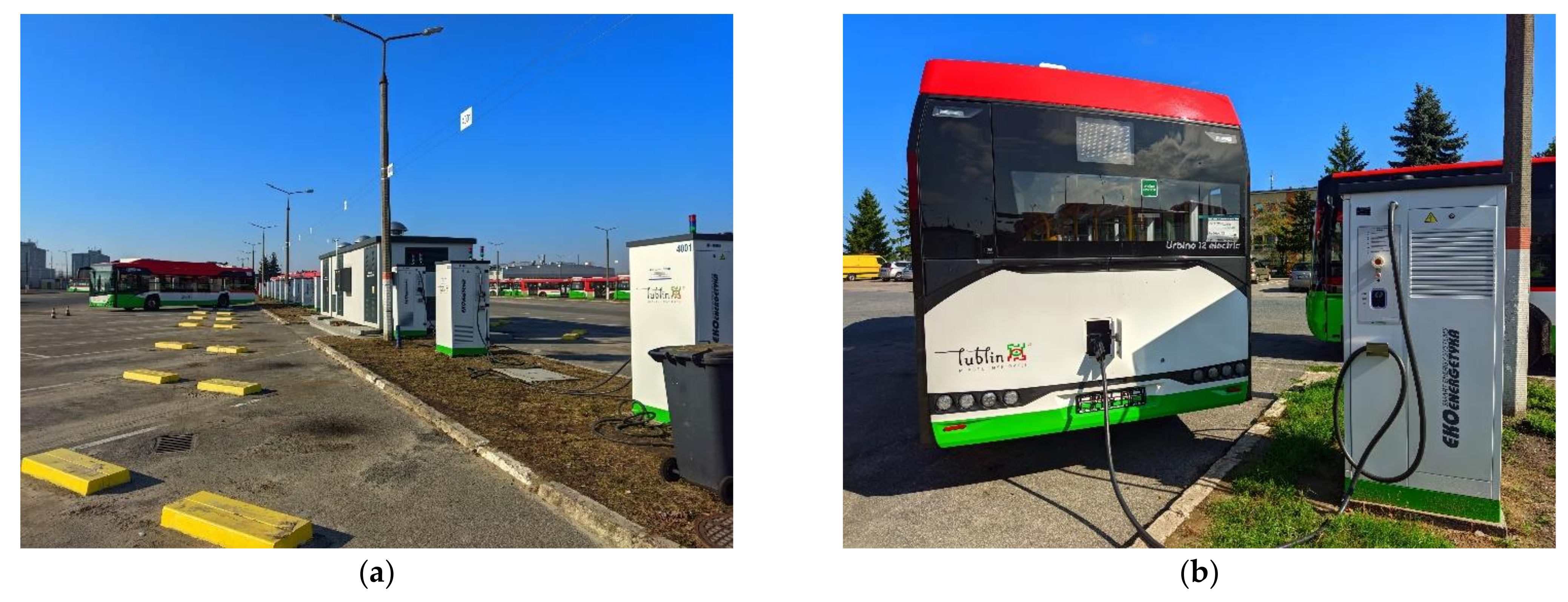


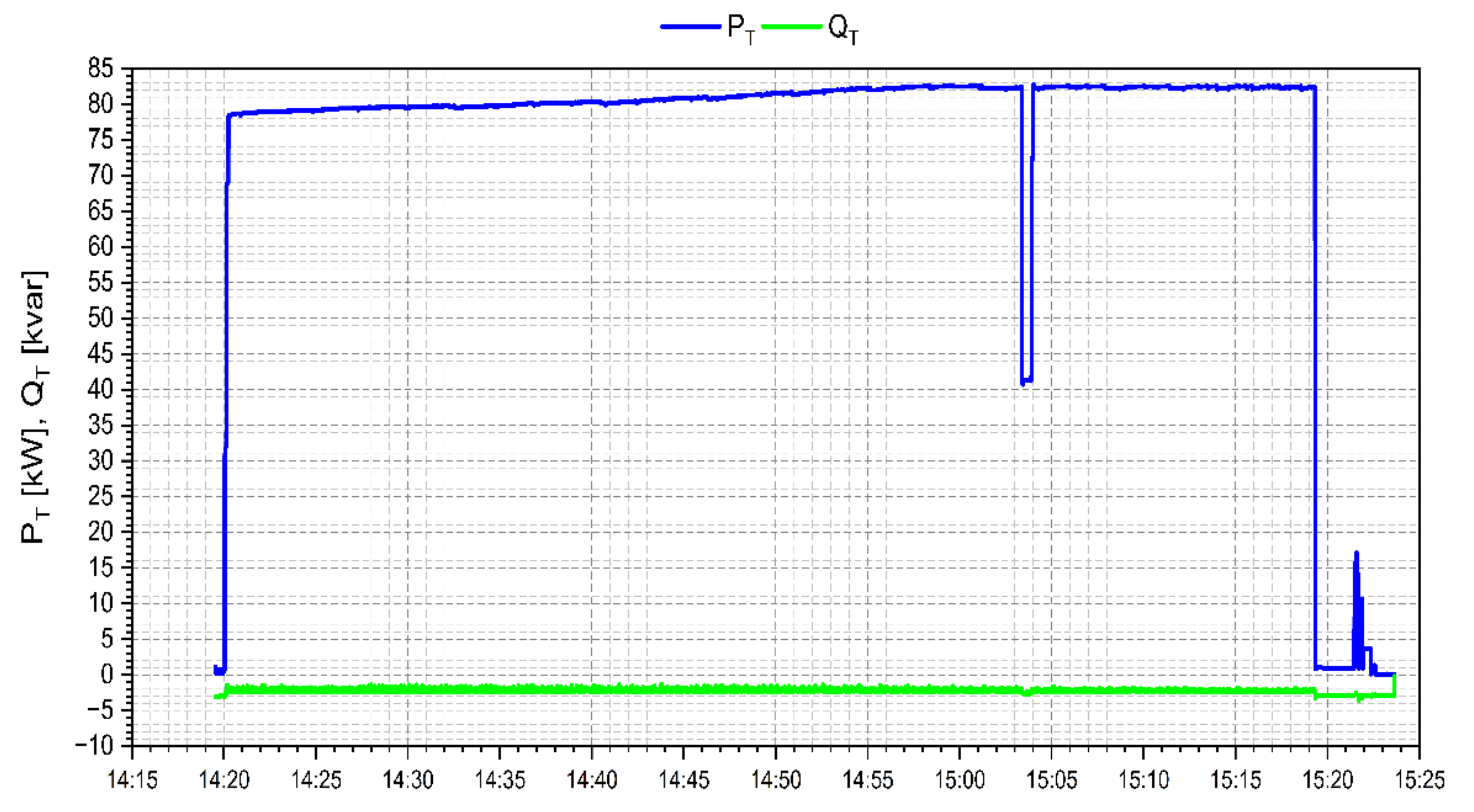
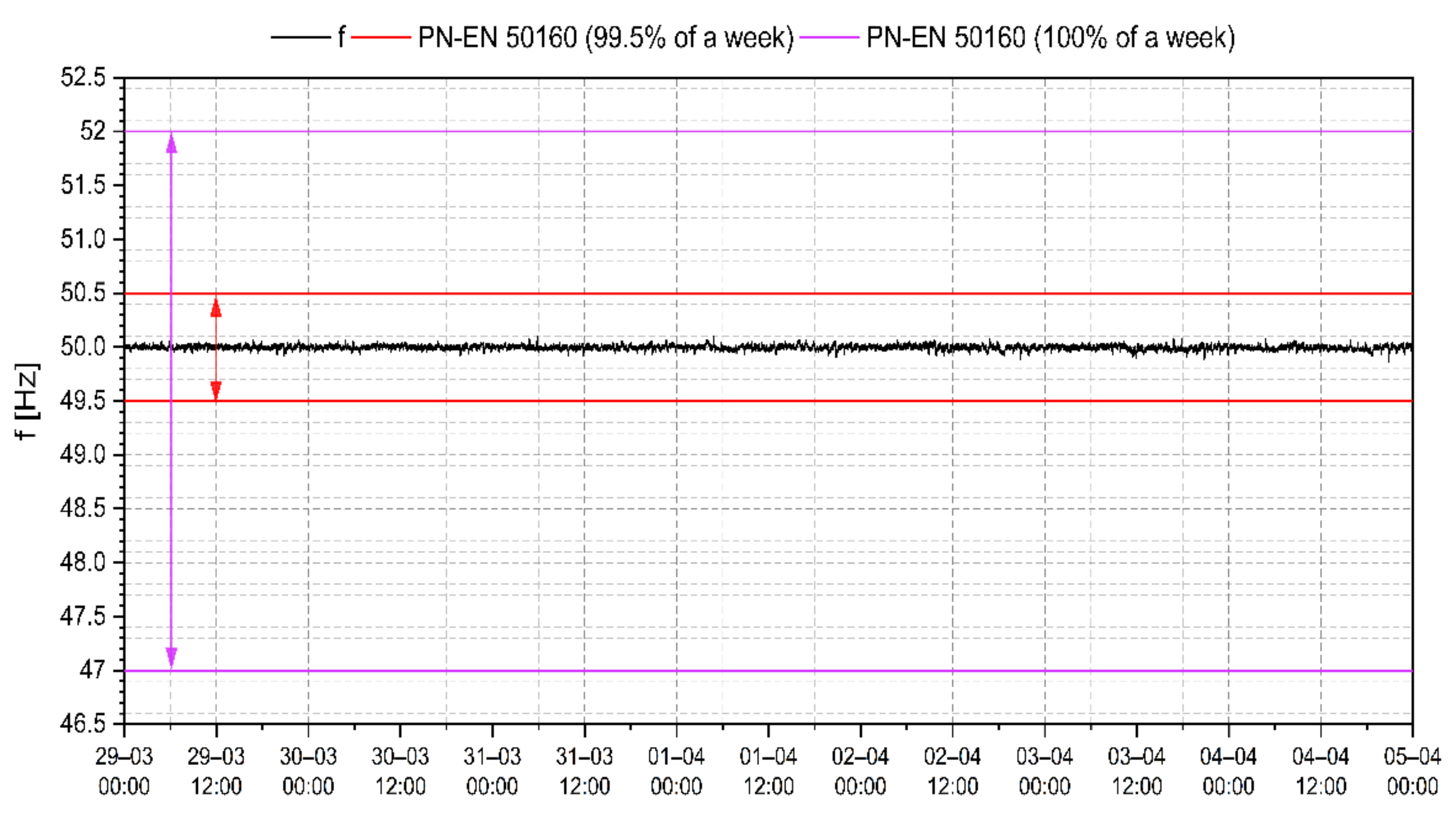
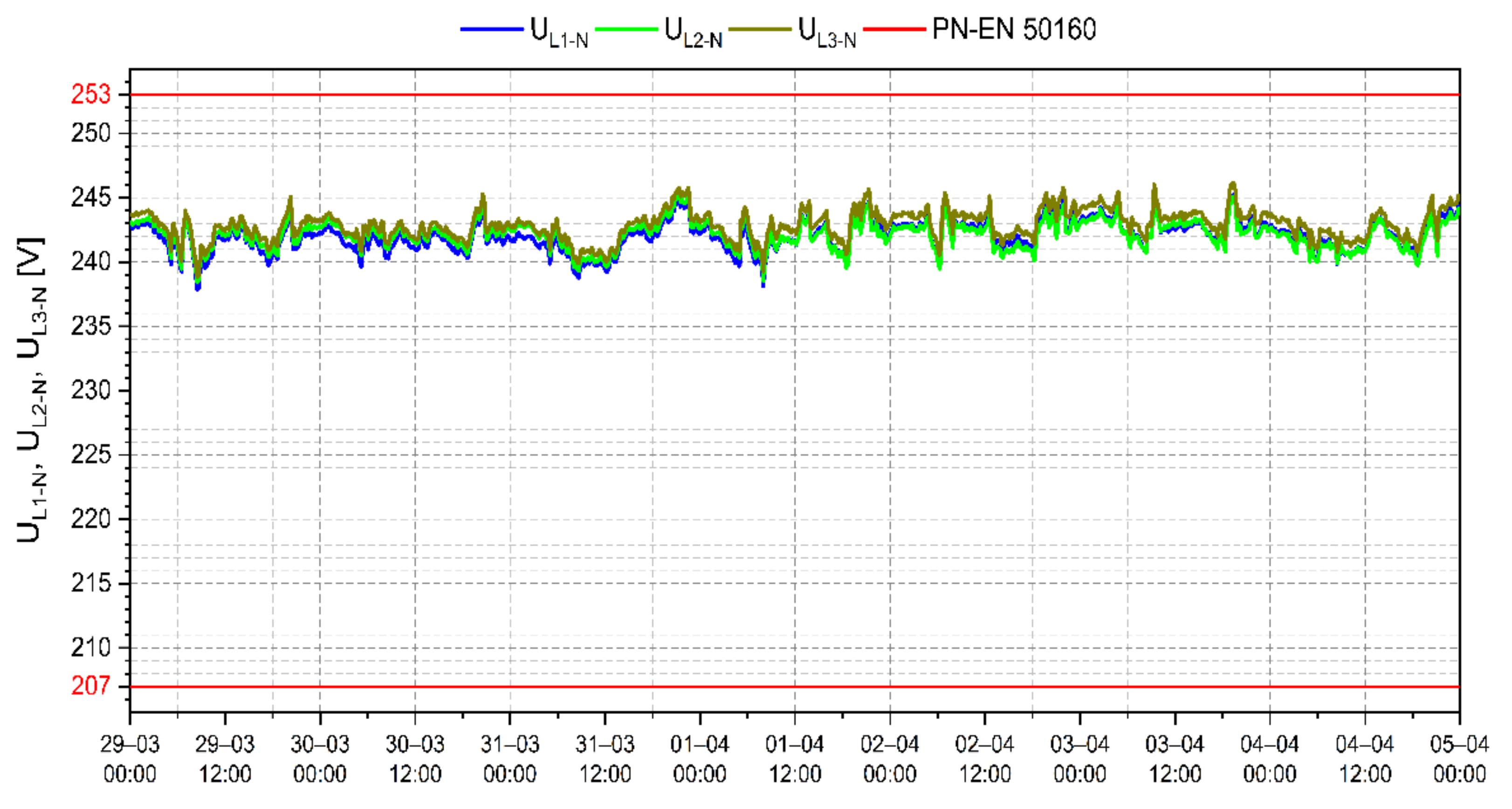
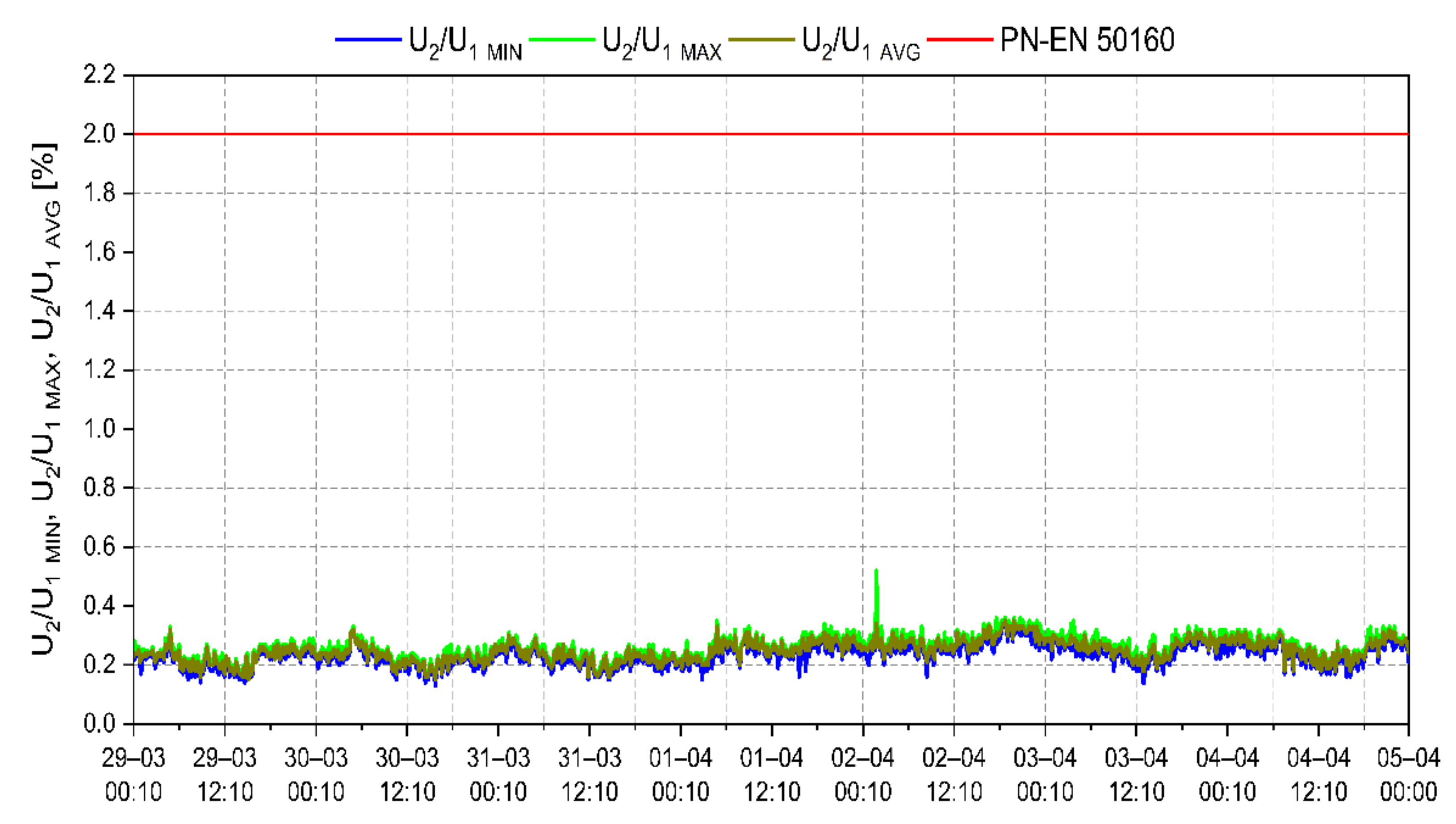
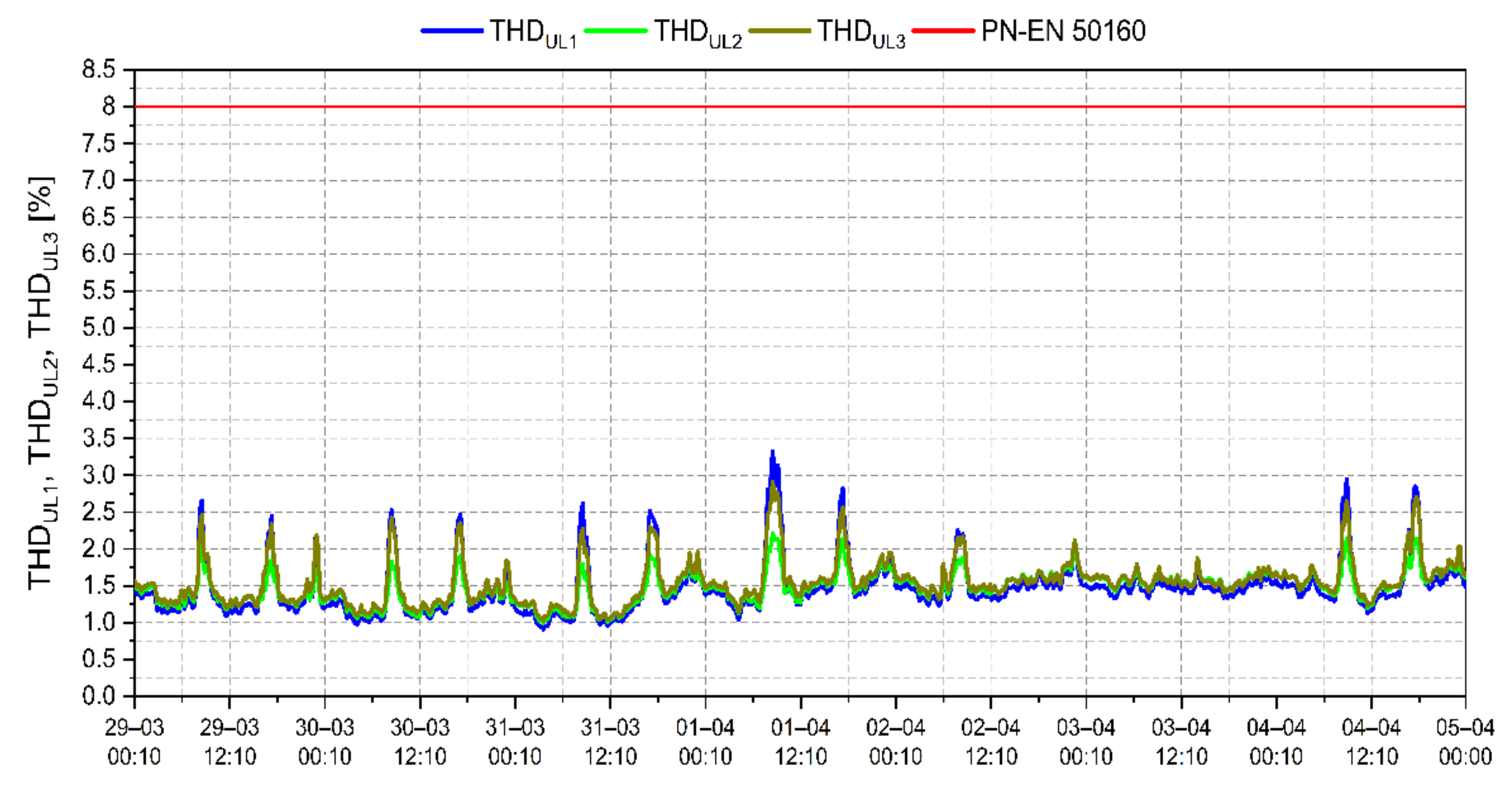
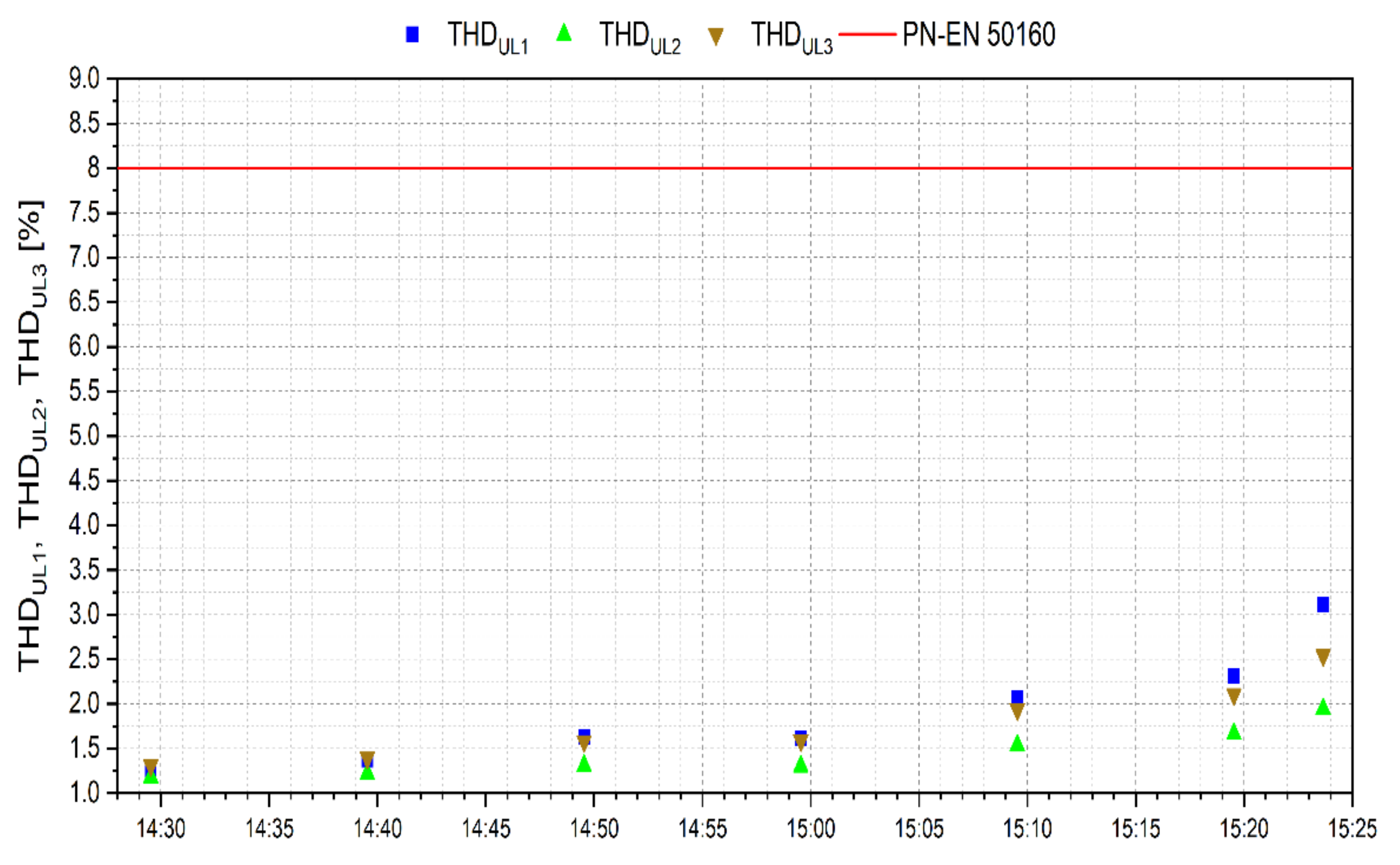
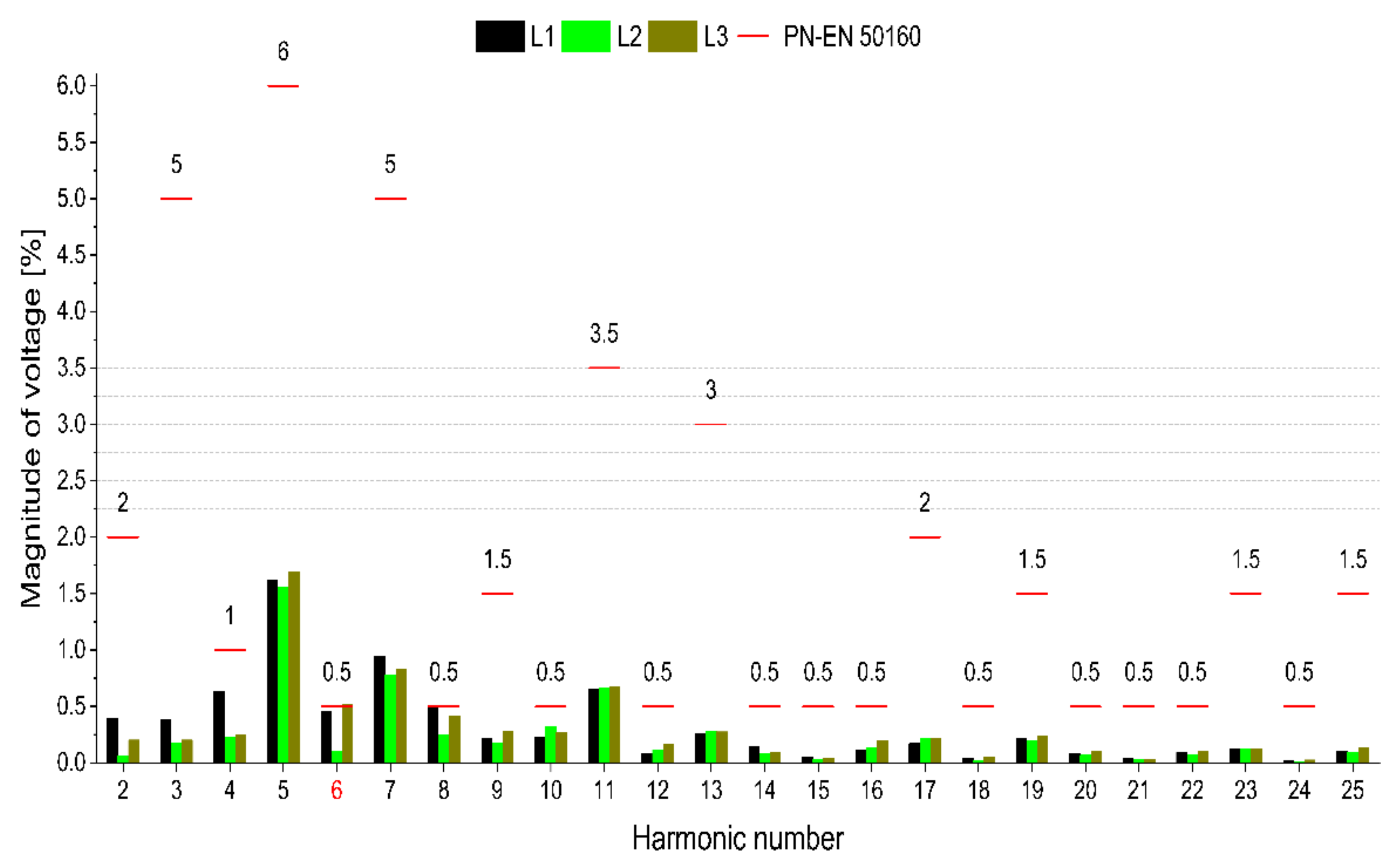

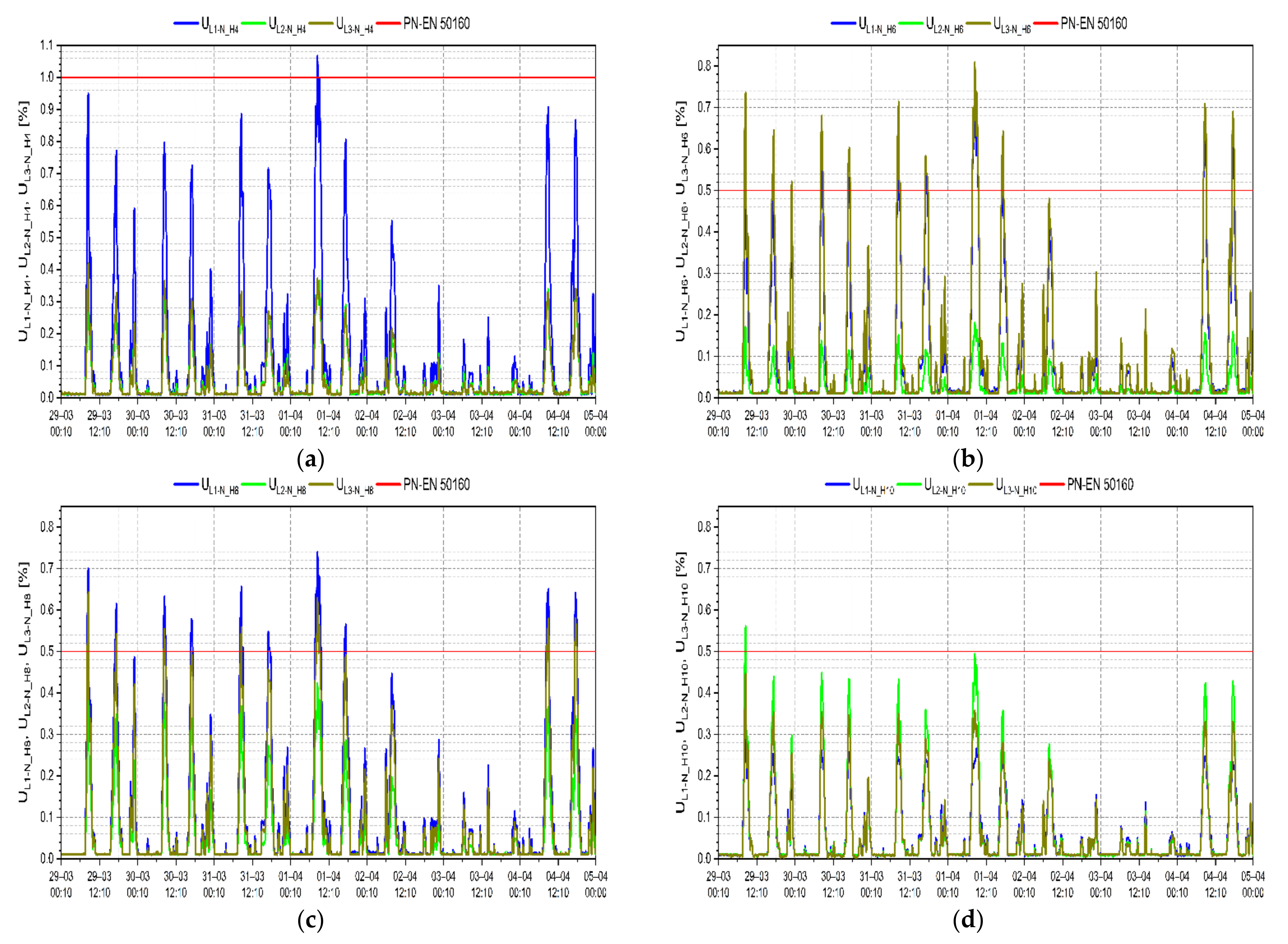
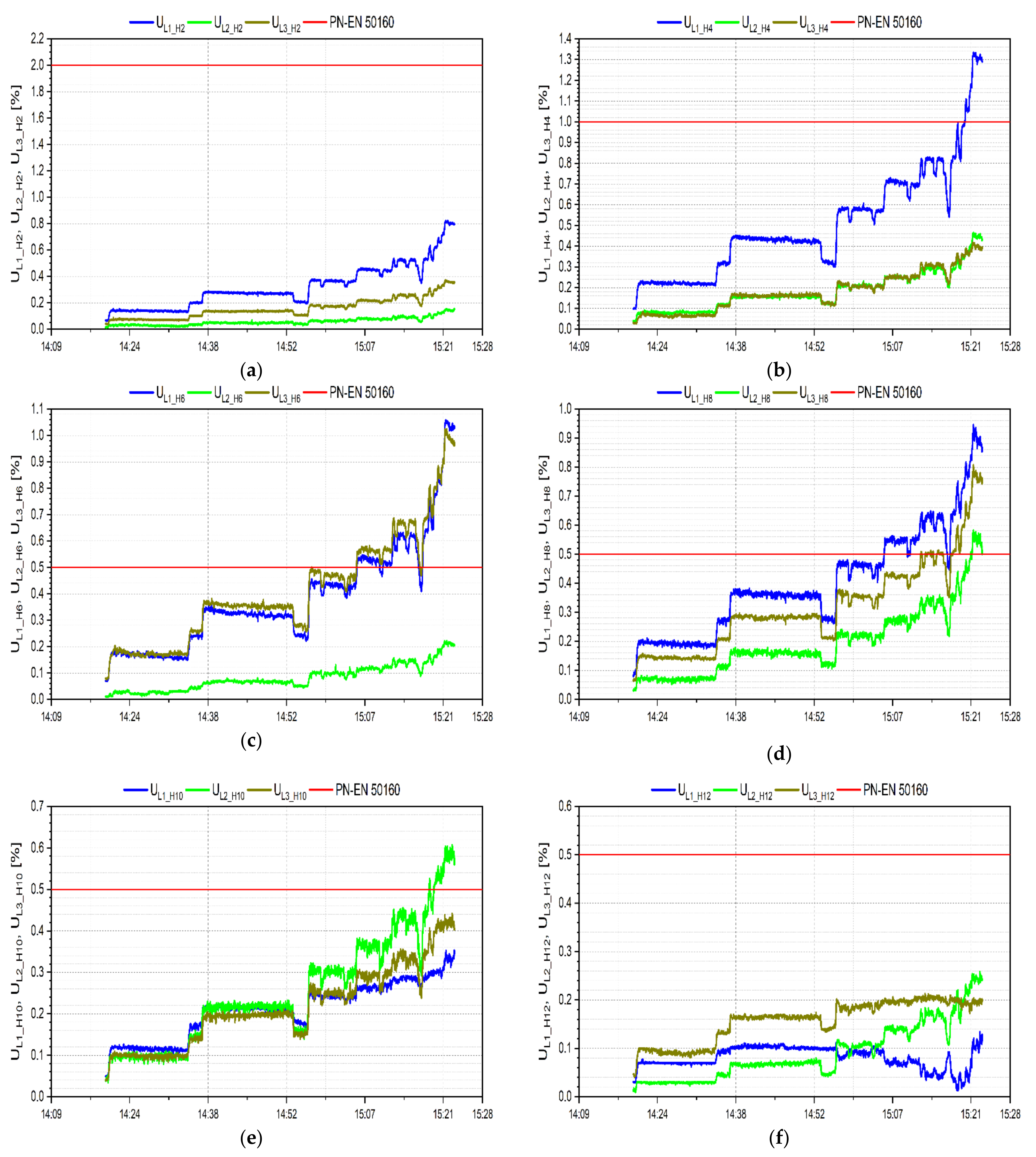
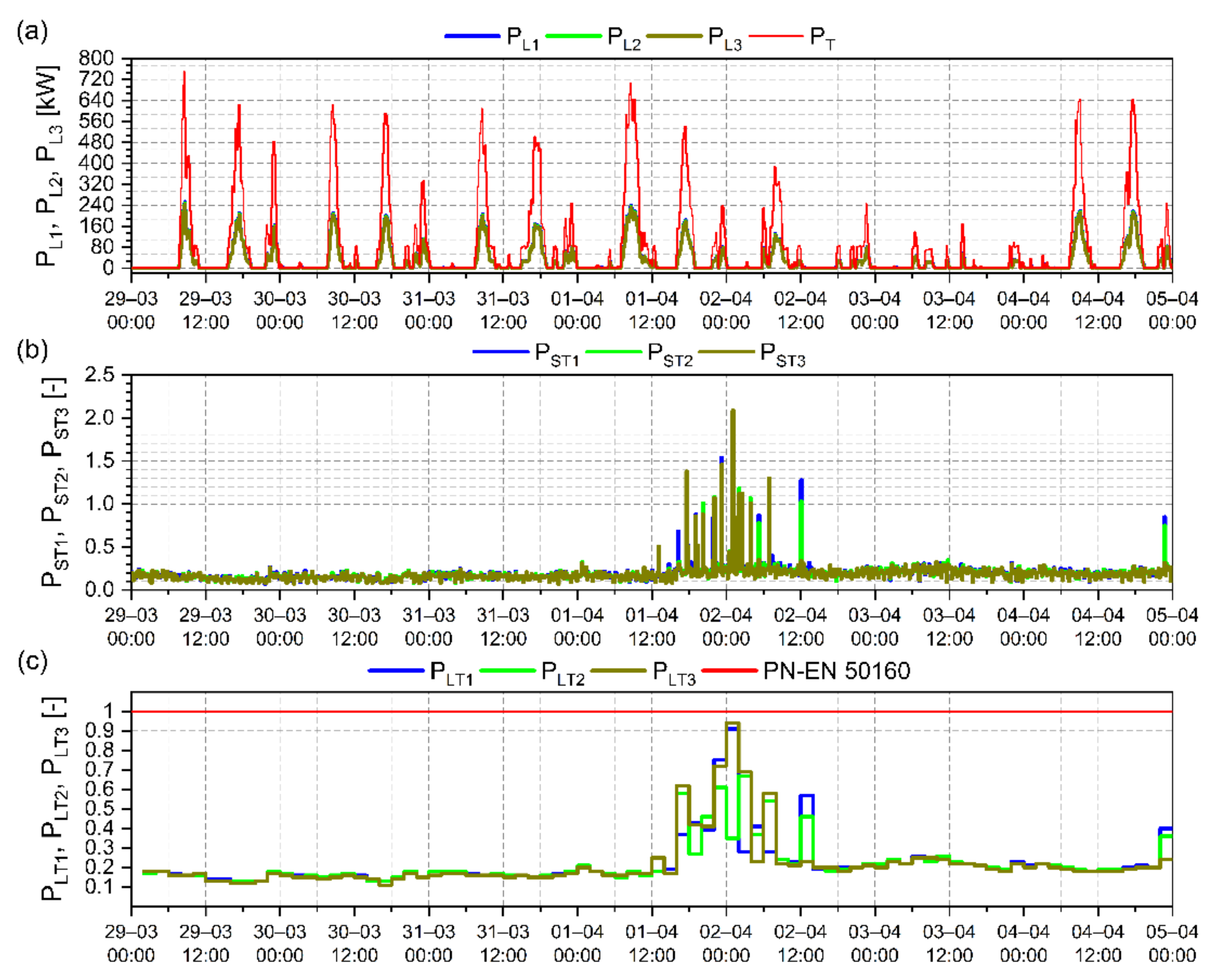
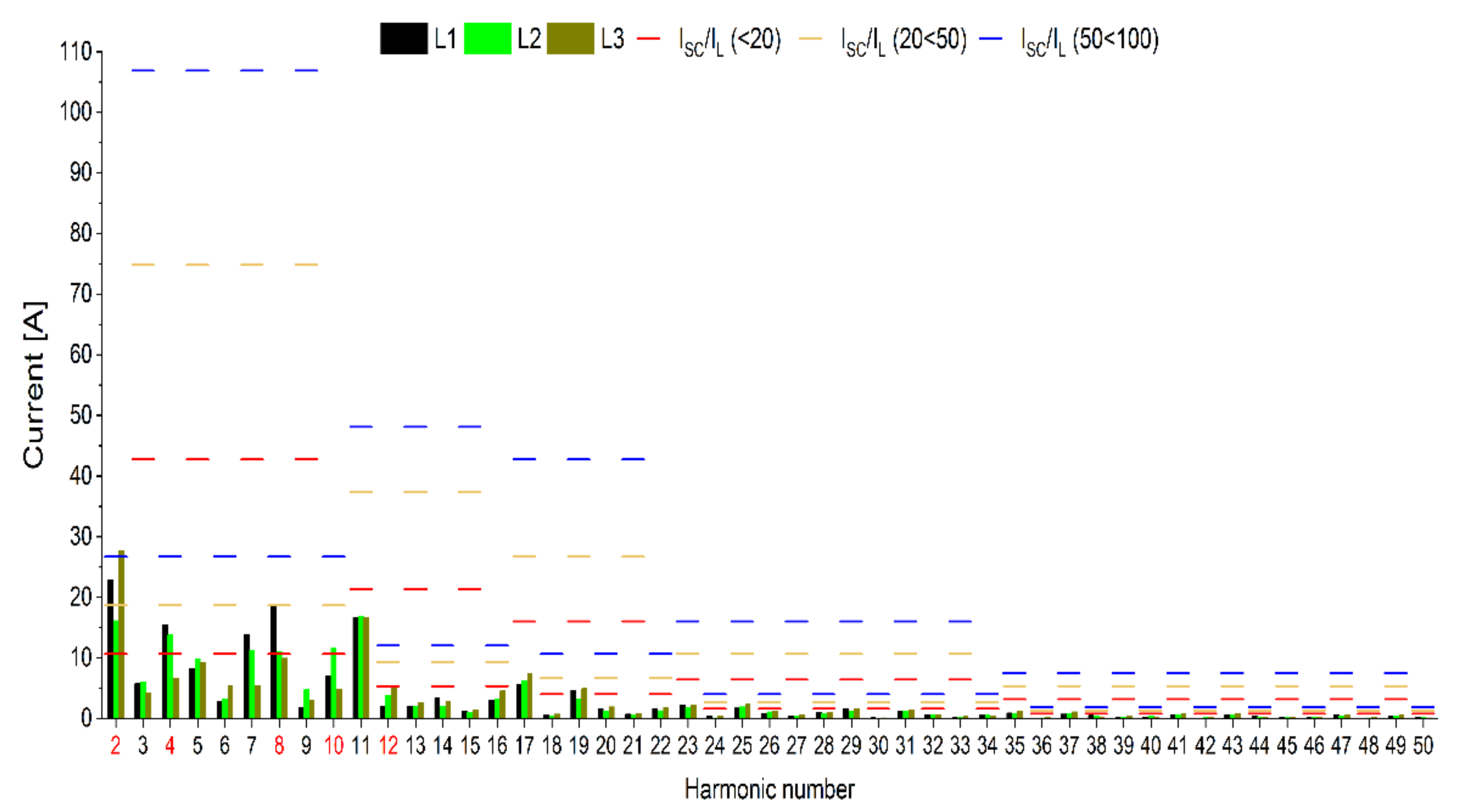


| Phase Voltage | Mean | Minimum | Maximum | P95 |
|---|---|---|---|---|
| UL1-N | 242.03 V | 237.9 V | 245.36 V | 244 V |
| UL2-N | 242.16 V | 238.43 V | 245.26 V | 243.82 V |
| UL3-N | 242.9 V | 238.89 V | 246.12 V | 244.8 V |
| UL1-N | 242.03 V | 237.9 V | 245.36 V | 244 V |
| Harmonic Number | PN-EN 50160:2010 Limit [%] | P95 L1 [%] | P95 L2 [%] | P95 L3 [%] |
|---|---|---|---|---|
| H2 | 2 | 0.40 | 0.07 | 0.20 |
| H3 | 5 | 0.39 | 0.18 | 0.20 |
| H4 | 1 | 0.64 | 0.23 | 0.25 |
| H5 | 6 | 1.63 | 1.56 | 1.69 |
| H6 | 0.5 | 0.46 | 0.10 | 0.52 |
| H7 | 5 | 0.95 | 0.78 | 0.83 |
| H8 | 0.5 | 0.49 | 0.25 | 0.42 |
| H9 | 1.5 | 0.22 | 0.17 | 0.28 |
| H10 | 0.5 | 0.23 | 0.32 | 0.27 |
| H11 | 3.5 | 0.66 | 0.67 | 0.67 |
| H12 | 0.5 | 0.08 | 0.11 | 0.16 |
| H13 | 3 | 0.26 | 0.28 | 0.28 |
| H14 | 0.5 | 0.15 | 0.08 | 0.09 |
| H15 | 0.5 | 0.05 | 0.03 | 0.04 |
| H16 | 0.5 | 0.12 | 0.14 | 0.20 |
| H17 | 2 | 0.17 | 0.22 | 0.22 |
| H18 | 0.5 | 0.04 | 0.02 | 0.06 |
| H19 | 1.5 | 0.22 | 0.19 | 0.24 |
| H20 | 0.5 | 0.08 | 0.07 | 0.11 |
| H21 | 0.5 | 0.04 | 0.03 | 0.03 |
| H22 | 0.5 | 0.09 | 0.07 | 0.10 |
| H23 | 1.5 | 0.13 | 0.12 | 0.13 |
| H24 | 0.5 | 0.02 | 0.01 | 0.03 |
| H25 | 1.5 | 0.10 | 0.10 | 0.13 |
| N total | Mean | Minimum | Median | Maximum | P95 | |
|---|---|---|---|---|---|---|
| PST1 | 1008 | 0.19 | 0.07 | 0.18 | 2.05 | 0.29 |
| PST2 | 1008 | 0.19 | 0.07 | 0.18 | 1.03 | 0.28 |
| PST3 | 1008 | 0.19 | 0.07 | 0.17 | 2.09 | 0.27 |
| PLT1 | 84 | 0.22 | 0.11 | 0.18 | 0.91 | 0.41 |
| PLT2 | 84 | 0.22 | 0.13 | 0.18 | 0.67 | 0.46 |
| PLT3 | 84 | 0.22 | 0.11 | 0.18 | 0.94 | 0.58 |
Publisher’s Note: MDPI stays neutral with regard to jurisdictional claims in published maps and institutional affiliations. |
© 2022 by the authors. Licensee MDPI, Basel, Switzerland. This article is an open access article distributed under the terms and conditions of the Creative Commons Attribution (CC BY) license (https://creativecommons.org/licenses/by/4.0/).
Share and Cite
Chudy, A.; Hołyszko, P.; Mazurek, P. Fast Charging of an Electric Bus Fleet and Its Impact on the Power Quality Based on On-Site Measurements. Energies 2022, 15, 5555. https://doi.org/10.3390/en15155555
Chudy A, Hołyszko P, Mazurek P. Fast Charging of an Electric Bus Fleet and Its Impact on the Power Quality Based on On-Site Measurements. Energies. 2022; 15(15):5555. https://doi.org/10.3390/en15155555
Chicago/Turabian StyleChudy, Aleksander, Piotr Hołyszko, and Paweł Mazurek. 2022. "Fast Charging of an Electric Bus Fleet and Its Impact on the Power Quality Based on On-Site Measurements" Energies 15, no. 15: 5555. https://doi.org/10.3390/en15155555
APA StyleChudy, A., Hołyszko, P., & Mazurek, P. (2022). Fast Charging of an Electric Bus Fleet and Its Impact on the Power Quality Based on On-Site Measurements. Energies, 15(15), 5555. https://doi.org/10.3390/en15155555






